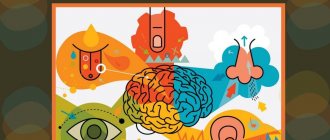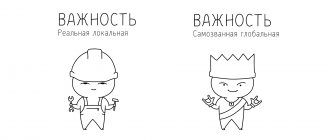Today, the most common form of psychotherapy is cognitive psychotherapy. It is based on the assumption that the causes of human mental problems are erroneous thoughts. If they are detected and eliminated, then you can not only get rid of various mental disorders, but also prevent their occurrence in the future.
Cognitive psychotherapy pays little attention to a person’s childhood memories, focusing on current problems, his inner world, thoughts, desires and fantasies. This is the main difference between this method of treating mental disorders and other popular types of psychotherapy: psychoanalysis and behavioral therapy.
The founder of cognitive therapy is Aaron Beck. Initially, he was engaged in psychoanalysis, but gradually became disillusioned with it and began to look for new methods of treating depression and affective disorders. Beck argued that the world around us is not bad, it is negative views of it that shape negative emotions and actions. Distortion of external circumstances in consciousness leads to the development of mental pathology, for example, depression.
Albert Ellis, the developer of the method of rational-emotive psychiatry, which has much in common with cognitive psychotherapy, worked independently of Beck. Today, cognitive therapy is a component of the cognitive-behavioral (behavioral) theory used by psychotherapists in their practice.
Fundamentals and objectives of cognitive behavioral psychotherapy
Cognition is a person’s ability to perceive and mentally process external events in accordance with their beliefs.
From childhood, a person acquires a number of rules and habits - both healthy and harmful, which interfere with life. Cognitive behavioral therapy is a branch of psychology based on the principle that thinking and behavior depend on a person’s habitual response. What does it mean? A certain person subconsciously reacts to external stimuli in a certain way that is unique to him.
How do we usually react to a disturbing event? We worry, are afraid, or feel unable to influence the situation. If you are under the influence of such negative emotions for a long time, this will inevitably lead to mental disorder. But you can give up such a “bad habit” by learning to perceive events differently in order to more easily cope with difficulties and avoid stress.
The main task of the CBT psychologist will be to teach the patient how to correctly work with his thoughts and a new attitude towards difficult situations that arise. This therapy is carried out in several stages and gradually forms life-affirming stereotypes of consciousness. Ultimately, the patient masters techniques aimed at reducing the level of anxiety and overcomes situations that frighten him without the usual panics and fears.
CBT will help:
- identify disturbing thoughts that contribute to the emergence of fears, depression, phobias, panic attacks;
- review your lifestyle and transform it into a healthy norm (for example, avoid overload, change your daily routine, get rid of bad habits);
- consolidate new thinking and correctly confront emerging negative situations in the future;
- overcome shame for your weaknesses and anxieties, learn to share problems with loved ones and gratefully use their support.
Brief Biography of Aaron Beck.
Aaron Temkin Beck was born in 1921 in Providence, USA, into a Jewish family that emigrated in 1906 from western Ukraine.
Three years before the birth of their son, his parents lost their daughter, who died of the flu, and Aaron's mother never recovered from this loss. This led to the fact that the boy was brought up and grew up in an atmosphere of hopelessness and constant depression, in which his mother constantly remained. Perhaps it is for this reason that, after graduating from school, he entered the Department of Psychiatry at the University of Pennsylvania.
After graduating from university, Beck begins his own practice and works for quite a long time within the framework of the psychoanalytic concept in which he was educated. Over time, he becomes disillusioned with psychoanalysis and begins to look for his own path, which leads him to a very original theory for that time, which explains the origin of psychological problems in a different way.
In psychoanalysis, the main cause of an individual’s neurotic manifestations is considered to be factors of the unconscious, which, entering into an obvious or hidden contradiction with the super ego, give rise to neurotic manifestations (frustrations that appear as a result of destructive reactions to the world around us). The solution to the problem within the framework of this school is seen as the therapeutic method of psychoanalysis, which consists in the patient’s awareness of his unconscious manifestations and the direct connection of neurosis with early traumatic experiences. The key to successful psychoanalysis is the subsequent reappraisal of the initially traumatic event and the reduction of its significance for the patient.
Within the framework of behaviorism, the cause of neurotic manifestations was considered to be the patient's maladaptive behavior, which was developed gradually in the course of personal history as a result of repeated influences (stimuli). The influences (stimuli) that gave rise to such behavioral strategies lay in the patient's past, but behavior therapy did not emphasize the importance of memories, as it did in psychoanalysis. Within the framework of the practical application of behavioral psychology, it was believed that a sufficient solution to psychological problems was the use of special teaching techniques to change the patient’s behavior, that is, changing a maladaptive strategy to an adaptive one. Behaviorists believed that developing correct behavior was the key to success.
As for Aaron Beck, his new concept lay beyond the mentioned methods and was very original for that time.
What are the benefits of CBT?
The most important advantage of using CBT is the sustainable long-term results. After undergoing cognitive behavioral psychotherapy, the patient is able to monitor, diagnose and treat complex conditions himself and becomes his own psychologist, so relapse is practically excluded.
In addition, CBT has a number of other advantages:
- high efficiency, proven by many clinical trials;
- short-term – usually about 10-15 consultations are required;
- provides a high-quality scientific basis, since the approach is based not only on psychology, but also on psychophysiology, neurobiology and other scientific movements;
- an action plan that is clear to the patient and therapist;
- pursues specific goals and solves specific problems that are discussed at the beginning of the sessions;
- recognized at the level of insurance companies, that is, the costs of CBT in some cases are covered through health insurance.
Basic principles of CBT
What is the basis of cognitive behavioral psychotherapy?
The main principles of the new thinking will be:
- Your experiences are only your personal vision and personal assessment of a specific situation, and not the result of past experience.
- You can radically change your assessment of the event and thoughts associated with it.
- Your negative beliefs, although they seem plausible, are not the truth. And it is from these beliefs that you experience psychological discomfort.
- Your anxious experiences are a pattern of thinking to which you have become accustomed. You have the power to change your way of thinking and check for errors in your usual beliefs.
Concept
Cognitive methods in psychotherapy work with the patient's thinking model .
The goal of cognitive therapy is awareness and correction of destructive patterns (mental schemes).
The result of treatment is complete or partial (at the patient’s request) personal and social adaptation of the person.
People, faced with unusual or painful events at different periods of their lives, often react negatively, creating tension in the body and brain centers responsible for receiving and processing information. This releases hormones into the blood that cause suffering and mental pain.
In the future, such a pattern of thinking is reinforced by repetition of situations, which leads to mental disorders. A person ceases to live in peace with himself and the world around him, creating his own hell .
Cognitive therapy teaches you to react more calmly and relaxed to inevitable changes in life, turning them into a positive direction with creative and calm thoughts.
The advantage of the &mdash method is working in the present tense, without focusing on:
- events in the past,
- influence of parents and other close people,
- feelings of guilt and regret about lost opportunities.
Cognitive therapy allows you to take your destiny into your own hands , freeing yourself from harmful addictions and the unwanted influence of others.
For successful treatment, it is advisable to combine this method with behavioral, that is, behavioral.
What is cognitive therapy and how does it work? Find out about it in the video:
What is a cognitive ability test for? Read about it here.
When will cognitive behavioral therapy help?
Cognitive behavioral therapy is successfully used by psychologists to overcome and correct in patients:
- anxiety disorders;
- schizophrenia;
- depressive states;
- types of addiction;
- eating disorders;
- phobias;
- obsessive-compulsive disorders;
- sleep disorders;
- antisocial behavior;
- psychosomatic diseases.
In addition, recently psychologists have proposed using CBT methods to help patients with chronic diseases. However, the effectiveness of this approach does not yet have strong evidence. But there is already a list of diseases for which CBT can successfully complement a medical treatment plan. These are bronchial asthma, hypertension, acute psychosis, irritable bowel syndrome, and unpleasant symptoms of menopause.
Summarizing the capabilities of the CBT technique, we can say that such therapy can be effectively used to correct psycho-emotional disorders and neurological disorders, and in some cases can become a good addition to the standard treatment regimen for chronic diseases. Therefore, knowledge of the CBT approach is recommended for those wishing to become a psychologist, practicing psychologists and psychotherapists of any direction, doctors and senior students of psychological and medical faculties. We offer everyone who is interested to take a distance learning course that will help them acquire the sought-after profession of psychologist or improve their existing knowledge.
Methods and techniques of cognitive behavioral therapy
In their sessions, CBT psychologists, depending on the key problem, use a variety of techniques to help identify, analyze and correct a person’s anxious perception of the situation. Often a person is afraid in advance of what he has prophesied for himself; on a subconscious level he expects bad things. This is how panic begins. With the help of CBT techniques, a person changes his thinking and significantly reduces the effect of negativity on his psycho-emotional state.
Let's look at the main existing CBT techniques:
- One of the most common methods is Socratic dialogue
. The therapist asks the patient questions in such a way that he himself can find the source of his established rules. The specialist listens to the answers and draws the client’s attention to logical contradictions. Next, the arguments for and against are jointly discussed, the meaning and influence of thought on the psychological state is explored. As a result, the patient shows a willingness to reconsider his beliefs, comes to new conclusions and, accordingly, to new behavior. - Therapy according to the Beck method
. According to the founder of this method, individuals who are susceptible to negative emotions and suffer from low self-esteem more often suffer from neurotic conditions. Such people are aimed in advance at a bad outcome of any situation. For example, a boss makes a remark to an employee based on the results of the work performed, and the employee thinks: “Now I will definitely be fired, I won’t be able to find another job, I won’t have anything to feed my family,” as a result, despondency sets in. The Beck approach is a series of quick questions and answers to identify negative thoughts, during which an understanding of the problem and ways to relieve the dangerous state of depression comes.
- Ellis's Rational-Emotive Approach Technique.
REBT is a psychotherapeutic technique that effectively trains thinking skills and rational behavior. It is aimed at ridding the patient of rigid frameworks and established stereotypes in order to form a more flexible and positive worldview.
To summarize all of the above, it can be argued that cognitive behavioral psychotherapy provides a clear understanding of the origin of negative reactions and negative emotions of a person and offers specific routes to normalizing the emotional state. The CBT psychologist shows the client that nothing is impossible, and even in the most difficult situation you can enjoy life and control your fears.
The main idea of cognitive psychocorrection
The main idea of cognitive psychocorrection by A. Beck is that the decisive factor for the survival of the organism is the processing of information. As a result, behavioral programs are born. A person survives by receiving information from the environment, synthesizing it and planning actions based on this synthesis, i.e. developing your own behavior program. The program can be normal (adequate) or inadequate. In the case of a cognitive shift in information processing, an anomalous program begins to form.
Subscribe to our INSTAGRAM account!
Personality, according to A. Beck, is formed by schemas or cognitive structures, which represent basic beliefs (worldview). These schemas begin to form in childhood based on personal experiences and identification (comparing and finding similarities) with significant others. Each person forms his own concept of himself (self-image), others, the world and the concept of his existence in the world.
Schemas are stable cognitive structures that become active when exposed to certain stimuli, stress, or circumstances. Schemas can be either adaptive or dysfunctional.
The “cognitive triad of depression” includes:
- negative self-image (“I am unfit, worthless, a rejected loser”);
- negative view of the world (the person is convinced that the world makes excessive demands on him and erects insurmountable barriers to achieving goals and that there is no pleasure or satisfaction in the world);
- a nihilistic, negative view of the future (The person is convinced that the difficulties he is experiencing are insurmountable. Suicidal thoughts can arise from a feeling of complete hopelessness).
Thus, emotional disturbances and behavioral disorders are seen as arising from cognitive structures and as a consequence of actual cognitive processes (in which thought-cognition acts as intermediate variables).
Psychological disorders are associated with aberrations of thinking. By aberration of thinking, A. Beck understood disorders at the cognitive stage of information processing that distort the vision of an object or situation. Distorted cognitions, i.e. Cognitive distortions cause false beliefs and self-signals and, as a result, inadequate emotional reactions.
Cognitive biases are systematic errors in judgment influenced by emotions. These include:
1. Personalization - the tendency to interpret an event in terms of personal meanings. For example, people with increased anxiety believe that many events that are completely unrelated to them concern them personally or are directed against them personally.
2. Dichotomous thinking. In this case, a person tends to think in extremes in situations that touch his sensitive areas, such as self-esteem, with the likelihood of being in danger. An event is designated only in black or white, only as good or bad, beautiful or terrible. This property is called dichotomous thinking. A person perceives the world only in contrasting colors, rejecting halftones and a neutral emotional state.
3. Selective abstraction (extraction). This is the conceptualization (raising into a rule, law) of situations based on details extracted from the general context, while ignoring other information. For example, at a noisy party, a young man begins to be jealous of his girlfriend, who leaned towards another person in order to hear him better.
4. Arbitrary conclusions - conclusions that are unproven or even contradict the obvious facts. For example, a working mother concludes at the end of a hard day: “I am a bad mother.”
5. Overgeneralization is an unjustified generalization based on a single case. For example, a person made a mistake, but thinks: “I always do everything wrong.” Or after an unsuccessful date, a woman concludes: “All men are the same. They will always treat me badly. I will never succeed in relationships with men.”
6. Exaggeration (catastrophization) - exaggeration of the consequences of any events. For example, a person thinks: “If these people think badly of me, it will be simply terrible!”; “If I’m nervous during the exam, I’ll definitely fail and they’ll kick me out right away.”










